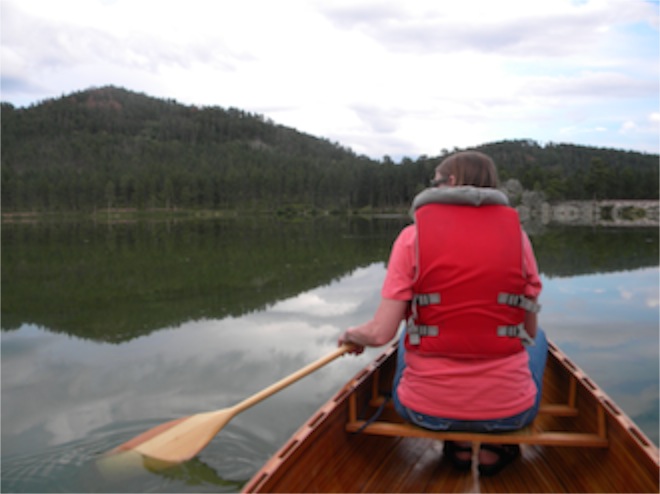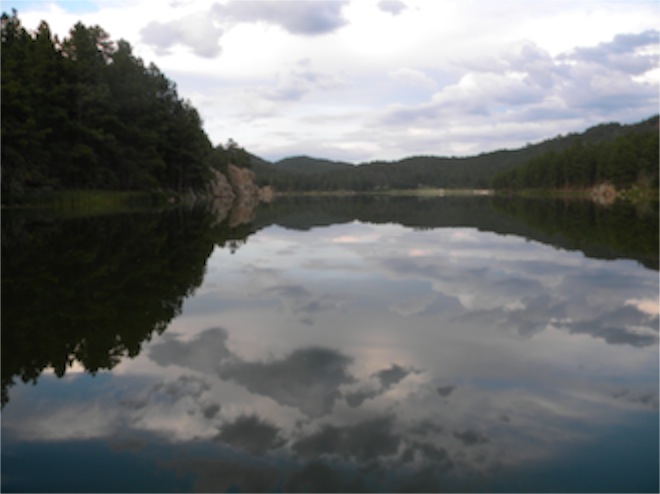Tandem
26/08/13 05:35
I like to think that the dominant pattern of our marriage has been side by side. Having passed our 40th wedding anniversary, we are well aware that we are a partnership. So many aspects of our lives are build around the things that we do together that it is not possible to imagine life apart. We were married in the early 1970’s, a time when we were becoming more aware of the roles that men and women play and the possibilities for increased equality in marriage. I grew up with parents who were equal partners in marriage and business and so I had good models of how to form a partnership. We have been intentional about forging a life where we go together side by side with neither taking the lead and neither being a follower. We are equals facing the world together.
But there are some things that are nice to do in tandem. Canoeing is one of those things. A canoe that is wide enough to sit side by side would be awkward and very slow on the water. Our long and slim boat is a far more efficient way to take to the water and we enjoy paddling together.
 For those who are not used to paddling tandem, there are a few things about the process that might not be evident. The person in the front of the boat may be leading, but the one in the back is the one who does the steering. There is lots of leverage in a paddle extended beyond the end of the boat and a simple flick of the wrist can have more authority than a sweep by the bow paddler.
For those who are not used to paddling tandem, there are a few things about the process that might not be evident. The person in the front of the boat may be leading, but the one in the back is the one who does the steering. There is lots of leverage in a paddle extended beyond the end of the boat and a simple flick of the wrist can have more authority than a sweep by the bow paddler.
Canoeing is one of those sports that takes just a few minutes to learn and is complex enough for a lifetime of study and practice. Full mastery is elusive and I am nowhere near, though I paddle a lot compared to other folks I know. Paddling tandem uses all of he same skills as paddling solo. The paddle strokes are the same. Remarkably, once the stern paddler has learned a few basic steering strokes, such as the J stroke and a basic pry stroke, the two paddlers do not need to be equal in ability or strength. There is a small advantage to having the most experienced paddler in the stern. The boat prefers to have the heaviest paddler in the stern for trim, except on the windiest of days. Fortunately in our case the heaviest paddler is also the most experienced. Back in the stern, I can alternate between siting on he seat and kneeling right in front of the seat and the boat stays well trimmed with Susan in the bow.
Tandem paddling is quicker than solo paddling in most cases. The strength of two people goes into the propulsion of the craft.
When we canoe, I sit in the back and we go through the water with a different partnership than the side-by-side that is our usual style. There is nothing less equal about a tandem relationship and even though the roles of bow and stern paddler are defined by the needs of the boat, there is a basic equality to the relationship.
There are other times when a tandem relationship works better than side-by side. Hiking narrow mountain trails is easier in single file than side-by-side. One has to lead and the other follow. On a longer hike, it makes sense to put the slower hiker in front so that the pace is naturally adjusted. If the faster one is in front, setting the right pace requires careful concentration on the pace of the other hiker. Reverse the order of the hikers and everyone can pay attention to the trail and the beauty unfolding as you walk. Hiking isn’t about speed in the first place. A slower pace can result in more endurance. And we hike for exercise and to see things that would be missed if we were going too fast. We hike to go places that aren’t accessible by other means. Sometimes slower is simply better. There is time to really see what is around you.
One of the discoveries over the years of our marriage is that side-by-side doesn’t mean that you are glued to each other. Space between partners is part of the ebb and flow of normal relationships. As time passes, trust grows and a natural balance of togetherness and separation develops. The complexities of life often demand a “divide and conquer” approach. We work well together, but there are many times when we need to be working separately. In the flow of activities, we seem to have forged a balance that always leaves us wishing we had just a little bit more time together. That wish is a good thing because when we do have time together we understand how precious it is and are able to savor it.
Stockade Reservoir in Custer State Park is a small pond, really. It is overgrown with aquatic plants and you cannot see through the water for all of the green growth in the pond. But it has an island and several coves worth exploring. Last night it was perfectly smooth and ours was the only craft on its surface. The water reflected the hills and the sky as we paddled. Our task didn’t require much talking, allowing for the chatter of the ducks to be the dominant sound. We had no set destination or schedule so we were able to paddle at a leisurely pace. It was a beautiful conclusion to a long and busy day that had been filled with worship, a host of people that needed to talk after worship, a retirement gathering for a colleague, and much more.
 A few paddle strokes out onto the lake, however, brought us to a place where the pace wasn’t critical. We were able to remember and process all of the events of the day. We were able to witness the glory of creation. We were able to share a moment. We may have been arranged in tandem, but we were truly together.
A few paddle strokes out onto the lake, however, brought us to a place where the pace wasn’t critical. We were able to remember and process all of the events of the day. We were able to witness the glory of creation. We were able to share a moment. We may have been arranged in tandem, but we were truly together.
We have been blessed. Our gratitude is beyond words.
But there are some things that are nice to do in tandem. Canoeing is one of those things. A canoe that is wide enough to sit side by side would be awkward and very slow on the water. Our long and slim boat is a far more efficient way to take to the water and we enjoy paddling together.

Canoeing is one of those sports that takes just a few minutes to learn and is complex enough for a lifetime of study and practice. Full mastery is elusive and I am nowhere near, though I paddle a lot compared to other folks I know. Paddling tandem uses all of he same skills as paddling solo. The paddle strokes are the same. Remarkably, once the stern paddler has learned a few basic steering strokes, such as the J stroke and a basic pry stroke, the two paddlers do not need to be equal in ability or strength. There is a small advantage to having the most experienced paddler in the stern. The boat prefers to have the heaviest paddler in the stern for trim, except on the windiest of days. Fortunately in our case the heaviest paddler is also the most experienced. Back in the stern, I can alternate between siting on he seat and kneeling right in front of the seat and the boat stays well trimmed with Susan in the bow.
Tandem paddling is quicker than solo paddling in most cases. The strength of two people goes into the propulsion of the craft.
When we canoe, I sit in the back and we go through the water with a different partnership than the side-by-side that is our usual style. There is nothing less equal about a tandem relationship and even though the roles of bow and stern paddler are defined by the needs of the boat, there is a basic equality to the relationship.
There are other times when a tandem relationship works better than side-by side. Hiking narrow mountain trails is easier in single file than side-by-side. One has to lead and the other follow. On a longer hike, it makes sense to put the slower hiker in front so that the pace is naturally adjusted. If the faster one is in front, setting the right pace requires careful concentration on the pace of the other hiker. Reverse the order of the hikers and everyone can pay attention to the trail and the beauty unfolding as you walk. Hiking isn’t about speed in the first place. A slower pace can result in more endurance. And we hike for exercise and to see things that would be missed if we were going too fast. We hike to go places that aren’t accessible by other means. Sometimes slower is simply better. There is time to really see what is around you.
One of the discoveries over the years of our marriage is that side-by-side doesn’t mean that you are glued to each other. Space between partners is part of the ebb and flow of normal relationships. As time passes, trust grows and a natural balance of togetherness and separation develops. The complexities of life often demand a “divide and conquer” approach. We work well together, but there are many times when we need to be working separately. In the flow of activities, we seem to have forged a balance that always leaves us wishing we had just a little bit more time together. That wish is a good thing because when we do have time together we understand how precious it is and are able to savor it.
Stockade Reservoir in Custer State Park is a small pond, really. It is overgrown with aquatic plants and you cannot see through the water for all of the green growth in the pond. But it has an island and several coves worth exploring. Last night it was perfectly smooth and ours was the only craft on its surface. The water reflected the hills and the sky as we paddled. Our task didn’t require much talking, allowing for the chatter of the ducks to be the dominant sound. We had no set destination or schedule so we were able to paddle at a leisurely pace. It was a beautiful conclusion to a long and busy day that had been filled with worship, a host of people that needed to talk after worship, a retirement gathering for a colleague, and much more.

We have been blessed. Our gratitude is beyond words.